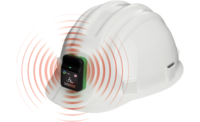Imagine a world in which construction workers' daily routine includes gaining access to their jobsites only after a machine scans the unique biological makeup of their irises or the geometry of their hands. In conjunction with the biometric scan, a security-pass lanyard is used. Each security pass carries a worker's information, including all the worker's credentials, OSHA certifications, ethnicity, gender—and even their home zip code. Multiply that scenario by 9,000 daily workers and you have a snapshot of the security technology deployed for the construction of London's 500-acre Olympic Park. For the 120,000 workers employed on the four-year project, this was a daily ritual, custom-built by the Olympic Park's security consultants.
The Olympic Park project may have been unique in the sheer scale of its use of biometric scans, but it's not the only jobsite using scanning technology to improve security. More construction projects are borrowing a page from the security industry and building new-age devices that solve many real construction problems while pushing the envelope of innovation. Is it worth the investment? Yes, if done right and designed for the scale and needs of your project, experts say.
Olympic Security
For the London Olympic Park, crews had a hard deadline to meet, and multidisciplinary engineering consultant Buro Happold Ltd. needed to quickly provide a highly secure system for worker entry.
"Inevitably, all the focus was on time," says Sir John Armitt, chairman for the Olympic Delivery Authority. "You can't deliver the Olympics late." But safety—and with it, security—were key to completion, he says.
With a looming deadline, the security consultant visited sites around the world to find the best security system. "We looked at 3D facial-recognition cameras, swipe cards and all manner of system configurations," says Andrew Sieradzki, security group director at Buro Happold. But in the benchmarking phase, he made a daunting discovery.
"We couldn't find anything that worked for the scale of our project, so we had to make our own," says Sieradzki. To do this, Sieradzki, with British security contractors Reliance High-Tech, Reading, and Human Recognition Systems, Liverpool, built a new technological structure.
With speed in mind, the team phased the system into place. Phase one was to install passive radio-frequency identification (RFID) cards to store worker identifications and details of their work approvals; the cards used encrypted ultra-high frequency (UHF) transmission. The security contractor used triple data- encryption security algorithms on the cards, similar to security for bank ATMs. "The encryption algorithms were very strong," according to Sieradzki.
The second phase was to install the system in modular entry-point units to secure the site further from possible terrorists posing as workers. The team attached the RFID reader to turnstiles, which workers had to pass through in order to reach the jobsite.
"We used hand-geometry and iris scanning," says Sieradzki. The primary method was hand-geometry scanning, which takes as little as four seconds.
The hand scanners were used on 95% of the workforce, but the secondary, iris-scanning method, which takes longer to use, was in place if a worker wasn't physically able to use the primary method. On days when some 5,000 workers arrived at once, scan times were critical, says Sieradzki. Enrolling everyone took the most time, he says.
"At the end, it was a 30% tech solution and 70% operational solution," according to Sieradzki. "It was dependent on operational parameters."
The parameters included checking the immigration status and passports of every employee when they came in to enroll in the system and get a 3D image of their hand and iris. "It's amazing how many people didn't show up," says Sieradzki.
Data Mining
Turner Construction Co., New York City, uses passive RFIDs at the South Africa embassy site in Washington, D.C., for security and to collect in-depth jobsite data. "Passive" RFID tags are dormant devices, each with a unique IP address, that "wake up" when exposed to electromagnetic waves from the readers. That's the key to the technology, says Kaan Celebi, project engineer for Turner. "It's the data you can collect from this technology that makes it useful to us."
At Turner's jobsites, all workers are funneled through one entrance with an RFID sensor portal, which reads a passive tag embedded in workers' hardhats.









Post a comment to this article
Report Abusive Comment